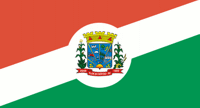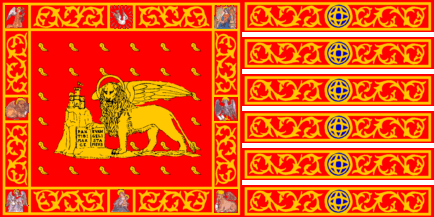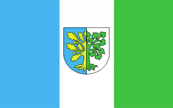![[Dharma Chakra]](../images/v/vxt-d1441.gif)
Buddhist Flag, Thailand (fotw)
Notes
a) "Dhvaja" is the Sanskrit word for “flag” and the examples shown above are
flown on festivals and other special occasions to mark the victory of Sanatana Dharma, however,
pennants dedicated to individual gods within the Hindu pantheon are also sometimes seen.
b) The word is sometimes pronounced
as d’vahjah, but other pronunciations exist.
![[Pont-à-Celles]](../images/v/vxt-d316.gif)
Flag of Pont-à-Celles, Belgium (fotw)

Flag of Honnelles, Belgium (fotw)

Flag of Cruzaltense, Brazil (fotw)

Flag of Flor do Sertão, Brazil (fotw)
![[diamond example]](../images/v/vxt-d1639.gif)
Flag of Mato Grosso, Brazil (fotw)
![[France]](../images/v/vxt-d114.gif)
![[Italy]](../images/v/vxt-d114a.gif)
![[Russia]](../images/v/vxt-d114b.gif)
![[Slovakia]](../images/v/vxt-d114c.gif)
![[Slovenia]](../images/v/vxt-d2382.gif)
![[Bulgaria]](../images/v/vxt-d114d.gif)
National Flag of France (fotw);
National Flag of Italy (fotw);
National flag of Russia (fotw);
National Flag of Slovakia (fotw);
National Flag of Slovenia (fotw);
National Flag of Bulgaria (fotw)
Please note with regard to 2) that in heraldry the terms difference and differencing may not have exactly the same meaning, that these terms do not necessarily equate directly with cadency as shown above and that we therefore suggest a dictionary or glossary on heraldry should be consulted for further details.

Flag of Venice, Italy (fotw)
![[dimidated flags]](../images/v/vxt-d115.gif)
![[dimidated flags]](../images/v/vxt-d115a.gif)
![[dimidated flags]](../images/v/vxt-d1570.gif)
![[dimidated flags]](../images/v/vxt-d1571a.gif)
![[dimidated flags]](../images/v/vxt-d1571b.gif)
![[dimidated flags]](../images/v/vxt-d2410a.gif)
![[dimidated flags]](../images/v/vxt-d2410.gif)
From left: Flag and Arms of Nysa, Poland (fotw); Flag of the Cinque Ports, UK (fotw); Arms and Flag of Gnoen, Germany (Klaus-Michael Schneider),
Arms and President’s Flag, Kujavia-Pomerania, Poland (fotw)
Please note, however, that where two sets of dimidiated arms or any elements thereof are set side by side (as illustrated above), in heraldic terms they are said to be ‘impaled by dimidiation’, and that (whilst this is often the case) one dimidiated charge, or set of dimidiated arms, need not necessarily (as per the example below) be set beside another so halved - see ‘entire 1)’ (also ‘conjoined’).
![[dimidated flags]](../images/v/vxt-d-115a.gif)
![[dimidated flags]](../images/v/vxt-d2411a.gif)
![[dimidated flags]](../images/v/vxt-d2411.gif)
Flag of Geneva, Switzerland (fotw);
Arms and Flag of Krásné Pole, Czech Republic (fotw)


Arms and Flag of Kornowac, Poland (fotw)
Please note that the usual protocol with regard to flying a flag in the half-mast position on land is not followed at sea.
![[diplomatic flags]](../images/v/vxt-d116.gif)
![[diplomatic flags]](../images/v/vxt-d2212.gif)
![[diplomatic flags]](../images/v/vxt-d2213.gif)
![[diplomatic flags]](../images/v/vxt-d2211.gif)
Ambassador’s Flags – UK,
Thailand,
Gambia and US (fotw)
Please note that these flags are not generally flown outside embassies or consulates (although they may be), but are more usually seen ashore as car flags, within diplomatic premises and/or outside the residences of ambassadors or consuls, or they may be flown from the main masthead or a jack staff of a vessel carrying a diplomatic or consular officer when afloat (see also ‘car flag’, ‘jack staff’, ‘main’ and ‘masthead’).
![[diplomatic flags]](../images/v/vxt-d2082.gif)
(trooping-the-colour.co.uk)
Notes
a) A warship will never dip its ensign
to another vessel (whether warship or merchantman) but will invariably return
the salute when offered by a merchant vessel - a courtesy that (whilst formerly
given as a matter of course) is rarely seen today – and that that warships only
return salutes from the ships of countries recognized by their own government.
Saluting between warships not wearing the flag of a flag officer or a broad pennant
is carried out by bosun’s call or bugle, and when flag officers meet at sea they
salute each other with the appropriate number of guns, although usually only by
prior arrangement (see also
'flag of command',
‘flag officer’,
‘gun salute’ and
‘private ship’).
b) At sea a manoeuvring signal
will be dipped by the flagship when it has been acknowledged, and signifies that
the signal is to be executed, however, an answering or code pennant flown at the dip in
response to a hoist from the flagship, indicates that the signal is not understood
- an answering pennant flown close-up confirms that the signal has been received
and understood (see also ‘code pennant’, ‘close-up’,
‘dip, at the’, ‘hoist 2)’ and
‘signal flag’).

![[Hindu dhvaja]](../images/v/vxt-d113.gif)
![[Hindu dhvaja]](../images/v/vxt-d113a.gif)
![[Hindu dhvaja]](../images/v/vxt-d113b.gif)

![[Pont-à-Celles]](../images/v/vxt-d1307.gif)
![[diamond example]](../images/v/vxt-d598.gif)

